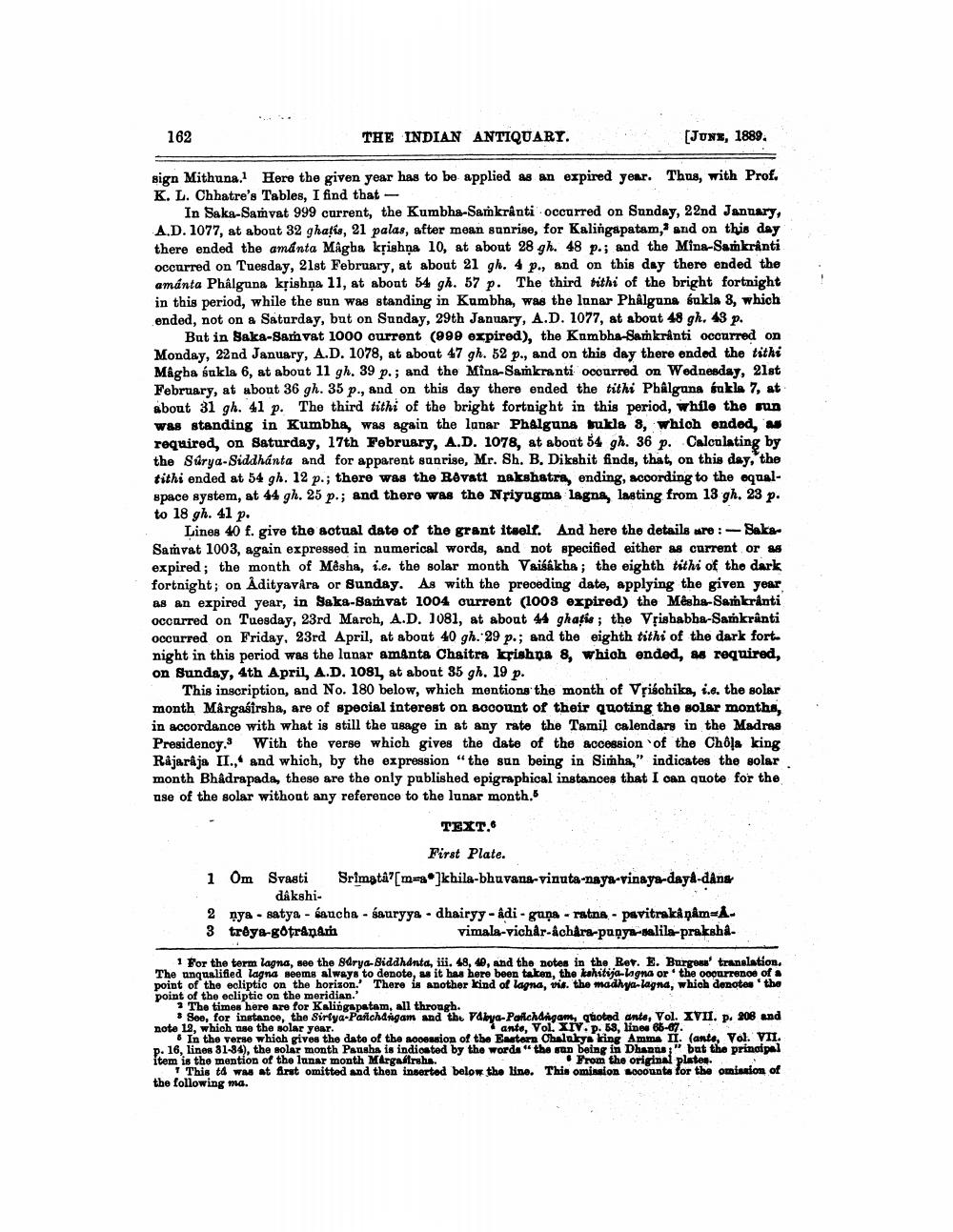________________
162
THE INDIAN ANTIQUARY.
[JUNE, 1889.
sign Mithuna. Here the given year has to be applied as an expired year. Thus, with Prof. K. L. Chhatre's Tables, I find that
In Saka-Samvat 999 current, the Kumbha-Samkranti occurred on Sunday, 22nd January, A.D. 1077, at about 32 ghatis, 21 palas, after mean sunrise, for Kalingapatam, and on this day there ended the amánta Magha krishna 10, at about 28 gh. 48 p.; and the Mina-Sankranti occurred on Tuesday, 21st February, at about 21 gh. 4 p., and on this day there ended the amanta Phalguna krishna 11, at about 54 gh. 57 p. The third tithi of the bright fortnight in this period, while the sun was standing in Kumbha, was the lunar Phâlguna sukla 3, which ended, not on a Saturday, but on Sunday, 29th January, A.D. 1077, at about 48 gh. 43 p.
But in Saka-Samvat 1000 current (999 expired), the Kumbha-Sankranti occurred on Monday, 22nd January, A.D. 1078, at about 47 gh. 52 p., and on this day there ended the tithi Mâgha śukla 6, at about 11 gh. 39 p.; and the Mina-Samkranti occurred on Wednesday, 21st February, at about 36 gh. 35 p., and on this day there ended the tithi Phalguna śukla 7, at about 31 gh. 41 p. The third tithi of the bright fortnight in this period, while the sun was standing in Kumbha, was again the lunar Phalguna bukla 8, which ended, as required, on Saturday, 17th February, A.D. 1078, at about 54 gh. 36 p. Calculating by the Surya-Siddhanta and for apparent sunrise, Mr. Sh. B. Dikshit finds, that, on this day, the tithi ended at 54 gh. 12 p.; there was the Revati nakshatra, ending, according to the equalspace system, at 44 gh. 25 p.; and there was the Nriyugma lagna, lasting from 13 gh. 23 p. to 18 gh. 41 p.
Lines 40 f. give the actual date of the grant itself. And here the details are:- SakaSamvat 1003, again expressed in numerical words, and not specified either as current or as expired; the month of Mêsha, i.e. the solar month Vaisakha; the eighth tithi of the dark fortnight; on Adityavara or Sunday. As with the preceding date, applying the given year as an expired year, in Saka-Samvat 1004 current (1008 expired) the Mêsha-Sankranti occarred on Tuesday, 23rd March, A.D. 1081, at about 44 ghatis; the Vrishabha-Samkrânti occurred on Friday, 23rd April, at about 40 gh. 29 p.; and the eighth tithi of the dark fort. night in this period was the lunar amânta Chaitra krishna 8, which ended, as required, on Sunday, 4th April, A.D. 1081, at about 35 gh. 19 p.
This inscription, and No. 180 below, which mentions the month of Vrischika, i.e. the solar month Mârgasirsha, are of special interest on account of their quoting the solar months, in accordance with what is still the usage in at any rate the Tamil calendars in the Madras Presidency. With the verse which gives the date of the accession of the Chôla king Rajaraja II., and which, by the expression "the sun being in Simha," indicates the solar month Bhadrapada, these are the only published epigraphical instances that I can quote for the use of the solar without any reference to the lunar month."
TEXT.
First Plate.
1 Om Svasti Srimata [m=a]khila-bhuvana-vinuta-naya-vinaya-daya-dans
dâkshi
2 nya - satya - saucha-sauryya dhairyy - âdi-guna - ratna pavitraka pâm-A3 trêya-götrânâm
vimala-vichar-âchara-punya-salila-praksha
·
1 For the term lagna, see the Surya-Siddhanta, iii. 48, 40, and the notes in the Rev. E. Burgess' translation. The unqualified lagna seems always to denote, as it has here been taken, the kahitija-lagna or the occurrence of a point of the ecliptic on the horizon. There is another kind of lagna, vis. the madhya-lagna, which denotes the point of the ecliptic on the meridian.'
2 The times here are for Kalingapatam, all through.
See, for instance, the Sirtya-Panchangam and the Fabya-Panchangam, quoted ante, Vol. XVII. p. 208 and note 12, which use the solar year. ante, Vol. XIV. p. 53, lines 65-67.
In the verse which gives the date of the accession of the Eastern Chalukya king Amma II. (ante, Vol. VII. p. 16, lines 31-34), the solar month Pansha is indicated by the words" the sun being in Dhanas;" but the principal item is the mention of the lunar month Margafirsha. From the original plates.
This tá was at first omitted and then inserted below the line. This omission accounts for the omission of the following ma.




